 Power outages happen. The important thing is how you deal with the next one to come your way. We are approaching the heart of hurricane season, which means it’s time to learn how your well and generator work together.
Power outages happen. The important thing is how you deal with the next one to come your way. We are approaching the heart of hurricane season, which means it’s time to learn how your well and generator work together.
One of the most common questions asked is how to use a generator along with a submersible well pump.
First, we need to talk about safety. One of the most common mistakes when using a generator is not installing a transfer switch. Transfer switches are required by the National Electric Code and are used to isolate your generated power from the utility power. Use of the transfer switch prevents the power from back-feeding into the utility power lines during power generation. (In addition to complying with the national code, be sure to follow local and state electrical codes.)
The next issue to address is sizing. When sizing a generator for the well pump, it is critical to ensure the size is correct, in order to prevent pre-mature pump failure. This mistake is frequently seen in using undersized generators. Some generators have the ability to start the pump when they are new, although with a little wear and tear on them they no longer have the ability to do so. For this reason, and many others, you should always research the available generator sizes for your specific needs. For example, if you are running a well pump only, a majority of pump manufacturers will have charts available for reference. Remember most generators are sized in watts. In order to get the total watts during run operation you need to multiply the volts by the amps to give you total running watts of the motor being used. Second, remember the start-up of the motor is critical when sizing the generator, too. To determine this, multiply again the starting amps by the volts to determine what the peak watts will be during start up.
There are some things you want to avoid while using a generator. These include: poor connections, undersized wiring, long runs of wire, and running out of fuel.
Perhaps one of the most important pieces of advice when it comes to operating a generator is to make sure you fully understand the manufacturer’s instructions. Remember that generators require proper ventilation for exhaust fumes. If you are ever in doubt, contact your Northeast Water Wells for additional guidance.

Recent Comments